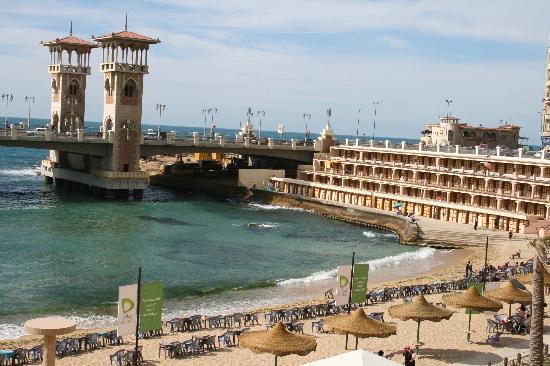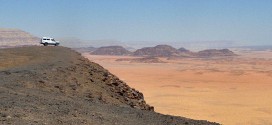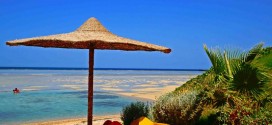
The second largest city and the main port of Egypt. The atmosphere of this city is more Mediterranean than Middle Eastern. Its ambience and its cultural heritage distance it from the rest of the country although it is only 225km from Cairo. Alexandria lies northwest of the Nile Delta and is linked to Cairo by the Delta Road (231km) and the Desert Road (225km).
Alexandria is one of the most frequented summer resorts in the Middle East and also known for its moderate winters. Famous also are the long beaches with soft sand and a magnificent scenery that stretches more than 40km along the Mediterranean Sea.
Founded by Alexander The Great in 331BC, Alexandria became the capital of Greco-Roman Egypt, its status as a beacon of culture verified by the Pharos Lighthouse, the Great Library and its setting for the stormy relationship between Cleopatra and Mark Anthony. The city, immortalizing Alexander’s name, flourished beyond expectations and became a prominent cultural, intellectual and economic metropolis, documented in the historical remains still evident to this day.
Alexandria was the renowned capital of the Ptolemies. It was the site of the Lighthouse, one of the Seven Wonders of the World, and the Great Library. It was along these shores that history took a tragic turn for Cleopatra, Julius Caesar, Mark Anthony and Octavian.
There is so much to see in this city. Only a brief overview of some of the sites can be listed below.
Touristic Attractions:
The Greco-Roman Museum
It houses a great collection (about 40,000 pieces) of rare Greek and Roman relics and coins from the 3rd Century BC to the 7th Century AD, including the “Tangara” collection. The museum also houses the artifacts recovered in 1995 from the site of the former Lighthouse.
Pompey’s Pillar
This granite pillar is over 25 meters high. Built amidst the ruins of the Serapium in honor of Emperor Diocletian, it is the most prominent remaining Greek landmark in Alexandria.
The Catacombs of Kom al-Shoqafa
The largest Roman cementery in Alexandria. It consists of three levels cut 30 meters deep into the natural rock. Dating to the beginning of the 2nd Century AD, it is a blend of Pharaonic and Roman art.
The Fort of Qaitbay
Erected on the northern tip of the Eastern Port on the site of the ancient Pharos of Alexandria, the fort design is influenced by both medieval architecture and by the original layout for the lighthouse. The fort also houses the Naval Museum.
The Roman Amphitheatre
The Amphitheatre is located downtown at Kom El-Dikkah and is considered unique in Egypt. Discovered only in the early 1960’s while laying the foundation of a new building, the Amphitheatre has twelve semi-circular marble rows in remarkably good condition.
El Shatby Necropolis
Constructed along the walls of old Greek houses, the Necropolis includes a doorway, a corridor and two chambers. It dates back to the 3rd Century BC and lies north of the College St. Mark.
The Tombs of Al-Anfushi
These five Ptolemaic tombs from the early 3rd Century BC were discovered in 1901 only. The tombs are cut into the natural rock and belong to Greek-Egyptians. These limestone tombs are richly decorated with pictures of Egyptian Gods and daily life scenes.
The Tombs of Mustafa Kamel
These four subterranean rock-hewn tombs date back to the 2nd Century BC. Influenced by the ancient Egyptian style, they are decorated in bright colors and with relief inscriptions of daily activities and religious believes of the burried.
The Mosque of Mursi Abul Abbas
This Andalusian-style mosque with four domes and a minaret is the largest in Alexandria. The mosque was rebuilt in the 20th Century at the former site of the Abul Abbas Shrine.
Montazah Palace
Built on a low plateau east of Alexandria surrounded by parks and forests and overlooking the Mediterranean Sea and the beaches, the palace comprises of several buildings, the most important being Al-Haramlek & Al-Salamlek, the summer residences of the former royal family.
Abu-Qir Suburb
One of the most tranquil beaches famous for fishing and seafood restaurants. The area is historically known as “Canopus” and contains several Greek and Roman monuments. It is the site of the Abu-Qir battle between Napoleon Bonaparte and the British Admiral Horatio Lord Nelson.
Museums:
The Museum of Fine Arts
Houses various collections of sculptures, paintings and architectural works. The museum also arranges exhibitions of contemporary artists. Furthermore, the museum organizes the Alexandria Biennale with art works from several Mediterranean counties.
The Hydrobiological Institute and Museum
Located at Al-Anfushi near the Fortress of Qaitbay, the museum houses a rare collection of fish and marine life.
The Royal Jewelry Museum
The palace of Princess Fatma El Zahraa is an architectural masterpiece. Its many rooms and halls contain rare paintings, statues and decorations, as well as a priceless collection of jewelry from the Mohamed Ali dynasty.
Other Attractions:
Alexandria Library
The most famous among all ancient and medieval libraries was the Library of Alexandria. Not only was it the largest of its kind but also was associated with scientific research. The Great Alexandrian Library was frequented by scholars from all over the world.
The Library of Alexandria promoted knowledge and openess to others, and for seven centuries was a symbol of learning and science. The library has been rebuilt and can be visited.
The Beaches
There are many beaches in Alexandria stretching from east to west: Maamura – Montaza – Assafra – Miamy – Sidi Bishr – San Stefano – Glym – Stanely – Rushdy – Sidi Gaber – Sporting – Ibrahimia and Shatby; all of which stretch along the seafront boulevard, the Corniche. On the western perimeter lie the beaches of Al Bitash and Hanoville Beaches.
Diving
Diving in Alexandria means to enjoy the first underwater museum of Cleopatra’s Empire, the ancient city of Alexandria, Palaces, Ships, and over 7000 Pharaonic and Greco Roman archaeological artifacts such as statues, columns, and amphoras. Although for centuries resting 8 to 15 meters under the sea, the antiquities have preserved their color and shape. Diving Sites: Qaitbay, Qaitbay 2, Qaitbay 3, East Harbour site 1, East Harbour site 2, Wrecks.
El Alamein
Site of the Second World War fierce battles of El Alamein. Several War Memorials and a small military museum containing some personal belongings of the German desert fox General Rommel can be visited.
 Sakura Travel World Group
Sakura Travel World Group








